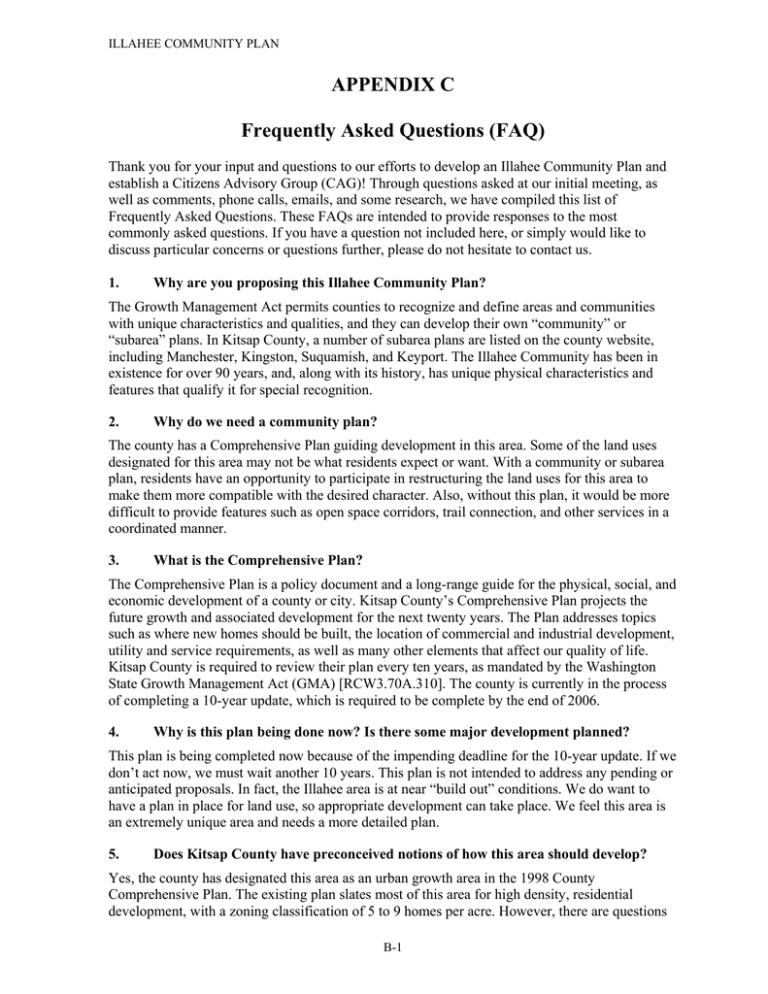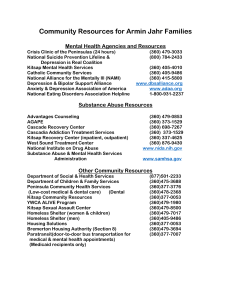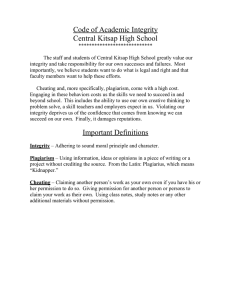Thank you for your input and questions
advertisement

ILLAHEE COMMUNITY PLAN APPENDIX C Frequently Asked Questions (FAQ) Thank you for your input and questions to our efforts to develop an Illahee Community Plan and establish a Citizens Advisory Group (CAG)! Through questions asked at our initial meeting, as well as comments, phone calls, emails, and some research, we have compiled this list of Frequently Asked Questions. These FAQs are intended to provide responses to the most commonly asked questions. If you have a question not included here, or simply would like to discuss particular concerns or questions further, please do not hesitate to contact us. 1. Why are you proposing this Illahee Community Plan? The Growth Management Act permits counties to recognize and define areas and communities with unique characteristics and qualities, and they can develop their own “community” or “subarea” plans. In Kitsap County, a number of subarea plans are listed on the county website, including Manchester, Kingston, Suquamish, and Keyport. The Illahee Community has been in existence for over 90 years, and, along with its history, has unique physical characteristics and features that qualify it for special recognition. 2. Why do we need a community plan? The county has a Comprehensive Plan guiding development in this area. Some of the land uses designated for this area may not be what residents expect or want. With a community or subarea plan, residents have an opportunity to participate in restructuring the land uses for this area to make them more compatible with the desired character. Also, without this plan, it would be more difficult to provide features such as open space corridors, trail connection, and other services in a coordinated manner. 3. What is the Comprehensive Plan? The Comprehensive Plan is a policy document and a long-range guide for the physical, social, and economic development of a county or city. Kitsap County’s Comprehensive Plan projects the future growth and associated development for the next twenty years. The Plan addresses topics such as where new homes should be built, the location of commercial and industrial development, utility and service requirements, as well as many other elements that affect our quality of life. Kitsap County is required to review their plan every ten years, as mandated by the Washington State Growth Management Act (GMA) [RCW3.70A.310]. The county is currently in the process of completing a 10-year update, which is required to be complete by the end of 2006. 4. Why is this plan being done now? Is there some major development planned? This plan is being completed now because of the impending deadline for the 10-year update. If we don’t act now, we must wait another 10 years. This plan is not intended to address any pending or anticipated proposals. In fact, the Illahee area is at near “build out” conditions. We do want to have a plan in place for land use, so appropriate development can take place. We feel this area is an extremely unique area and needs a more detailed plan. 5. Does Kitsap County have preconceived notions of how this area should develop? Yes, the county has designated this area as an urban growth area in the 1998 County Comprehensive Plan. The existing plan slates most of this area for high density, residential development, with a zoning classification of 5 to 9 homes per acre. However, there are questions B-1 ILLAHEE COMMUNITY PLAN about how this high density classification should fit with the semi-rural nature of this area and whether there are other classifications needed in this area. 6. When were the planning decisions made for this area? When the county last established its Comprehensive Plan in 1998, we feel they used a broad brush or blanket approach to defining future land use in this area. The county’s planning was done before the establishment of the Heritage Park and before the culverts were replaced on Illahee Creek in support of salmon runs. With the major changes that have taken place in our area over recent years, it is time we look at our area in more detail. 7. Why did you change the name of your project from “Illahee Subarea Plan” to “Illahee Community Plan?” We were asked by Kitsap County officials to do so. The officials said we were too late in the planning process to use the “subarea” title and still be considered as part of the 2006 Comprehensive Plan Update, which is due on December 31, 2006. They did say that if we developed a “community” plan in a timely manner that it could be considered as part of their 2006 update. There is a lead time necessary to create a standard subarea plan, and the county normally has a consultant work with the community to help with its preparation. We simply came to the table too late to take advantage of this service. 8. Why didn’t you start the subarea process earlier? The “critical mass” did not come about until late 2005, which was already too late for the subarea process. Our “critical mass” was essentially a number of events that made us realize the need to establish ourselves as a community and be involved in our future. Some of the major events leading up to our decision were: • The creation of the Illahee Preserve as a Heritage Park. • The new culvert for Illahee Creek increasing the viability of salmon runs. • The purchase of approximately 90 acres of creek corridor lands with grant money. • The Port of Illahee grant application to determine how to control storm water in Illahee Creek and other local watersheds. • A salmon grant approved to restore portions of Illahee Creek. • A primary and possibly secondary wildlife corridor area at and between Illahee State Park and the Illahee Preserve. • Our 90th anniversary as a unique community in Kitsap County. These items, coupled with watching others in the county define themselves as unique subareas, have resulted in a resurgence of community pride, community activism, and community independence. 9. What do the terms “community” or “subarea" mean? “Community” or “subareas” are just terms used to refer to a specific area within the Growth Management Area. Each community or subarea must establish the boundaries for its particular geographical area within the larger Growth Management Area. In this case, the area being considered for the community of Illahee is the boundary already established for the Port of Illahee and two logical fringe areas. B-2 ILLAHEE COMMUNITY PLAN 10. What does it mean that this area is within the larger Growth Management Area? A Growth Management Area (GMA) is an area on a map denoting areas of urban development. Cities and the county have defined their Growth Management Areas. It helps the governing bodies plan for providing public services and facilities in the future. We are within the Kitsap County GMA, but the boundaries are subject to change. The city of Bremerton could likely consider expanding its GMA boundary to the north, and Silverdale could someday be looking at becoming incorporated and would likely be expanding its GMA boundary south to the Bremerton GMA boundary. As such, we could find ourselves future residents of either Bremerton or Silverdale. Note: A proposal by some members of the Silverdale subarea committee did propose that its boundaries should be expanded east to the water and that would take in the Illahee area. 11. What issues will this plan address? The Illahee Community Plan will focus on issues involving land use, transportation, utilities, parks and recreation, storm water, greenways, and any other appropriate issues. 12. What are the biggest challenges for this plan? a. Residents and property owners who have different preferences and visions for the area need to come together to work out future solutions they all can support. b. While everyone so far has been enthusiastic about this effort, some community members may be skeptical about this plan, and yet we need everyone to be involved. c. Planning is difficult because of how we may feel about our rights as property owners. On the one hand, people often do not want to be told what to do with their property. On the other, they want their neighbor’s property to remain unchanged. How can we reconcile these two views? d. Our goal is to have a 70 to 80% approval rating of the community plan. This will require communication with nearly everyone within the community boundaries. Will Kitsap County be involved in this plan if we, as a community, prepare our own 13. plan? The county will be involved with this plan because the county will need to make decisions about this area’s future. Community plans help the counties make decisions about the services they provide and about land use development within their boundaries. This plan will address the various needs of the community and the best way to provide for those needs. Ideally, residents and property owners will come together to figure out how to plan for the type of area people want to see in the future while at the same time protecting property owners’ rights to sell and develop their properties. 14. How did you get this effort started? What were the steps and what is being planned? First, we began by discussing issues with neighbors to determine the general interest in the concept of a community plan. Next, we held a public meeting to determine if there was broader interest, which resulted in unanimous consent and the establishment of a Citizens Advisory Group. We will be conducting further public meetings to involve as many people as possible. Our goal is to have our community plan completed by summer of 2006. 15. How can I get involved and remain aware of the process and plan decisions? Sign up to receive project updates and meeting announcements. And, feel free to call any of the project contacts with questions at any time. B-3 ILLAHEE COMMUNITY PLAN 16. How do we know this process will make a difference? Your question asks whether the county will listen to the community. First, the Kitsap County Commissioners won’t approve this plan unless it has strong community support. If for you, “listening to the public” means we do what you as an individual wants, this may not happen. This is because there are many different people involved in this plan, and a successful plan will mean people with different wants, needs, and priorities come together to work out their differences and plan a future all can live with -- including the county. 17. Will community members be kept informed of all stages of the planning, and will we get to vote on the proposals? If you sign-up on the emailing list, we will keep you informed of all stages of the planning process. The plan presented to the Kitsap County Commissioners will be the result of public involvement where community members influence the alternatives to be studied, how they are evaluated, and what goes into the final plan. Community members need to help create this plan, not vote on it. 18. How are these plans for the future decided? Community residents and property owners work together with county staff to create a plan they can support. Typically, the plan doesn’t include everything any one person would want or not want, but represents a fair and realistic compromise that, hopefully, most people can support. Review and approval by the Kitsap County Planning Commission and by Kitsap County Commissioners is needed before any plan is adopted. 19. How will this plan benefit homeowners? Homeowners will benefit by being able to envision what their future looks like with regards to land use regulations and the natural resources within the area. 20. Will this plan pave the way for development? The reality is some development will occur on the community’s vacant lands with or without this plan. There is no legal, feasible way to prevent development other than outright property purchase by the county, which is unlikely to happen on most parcels. With that said, this plan will help us identify the type of development most compatible for the different areas and set up standards to regulate its layout and design. 21. What is your timeline for completing the plan? Our goal is to complete the plan by summer of 2006. Our brief schedule is as follows: February March April-May June July Present Proposal at Initial Public Meeting Distribute Questionnaire to Community Present Proposal at Expanded Public Meeting Present Proposal at Kitsap County Public Meeting (March 27) Develop Draft Community Plan (by Citizens Advisory Group) Distribute Draft Plan and Present at Public Meeting Present Final Plan to Kitsap County Contacts for further information are: Dennis Sheeran, 692-6971 Jim Aho, 479-1049 B-4

![[Date] Dear Parent or Guardian:](http://s2.studylib.net/store/data/017696306_1-85262427e2013cb1fd2940429bd0d877-300x300.png)
